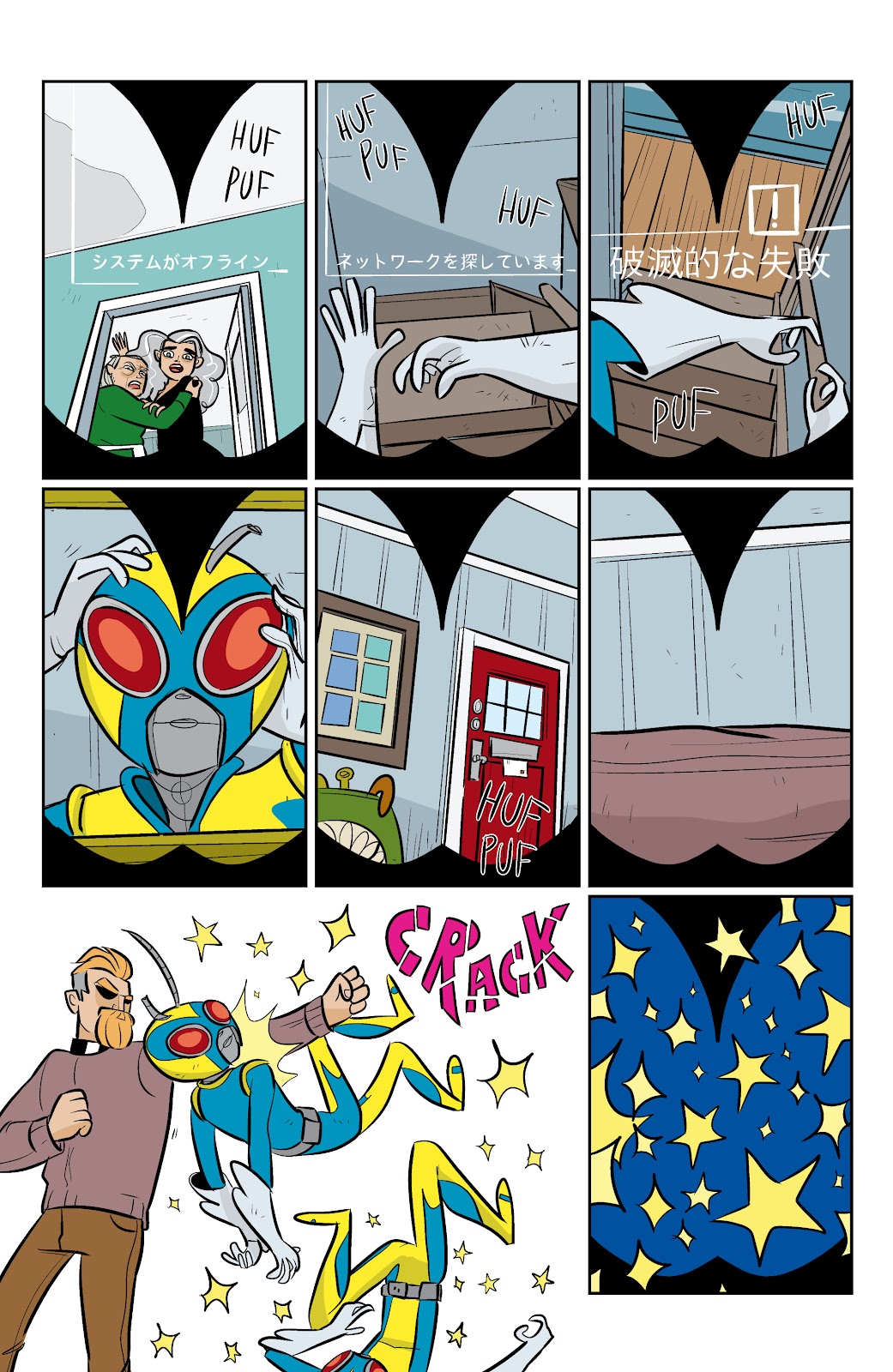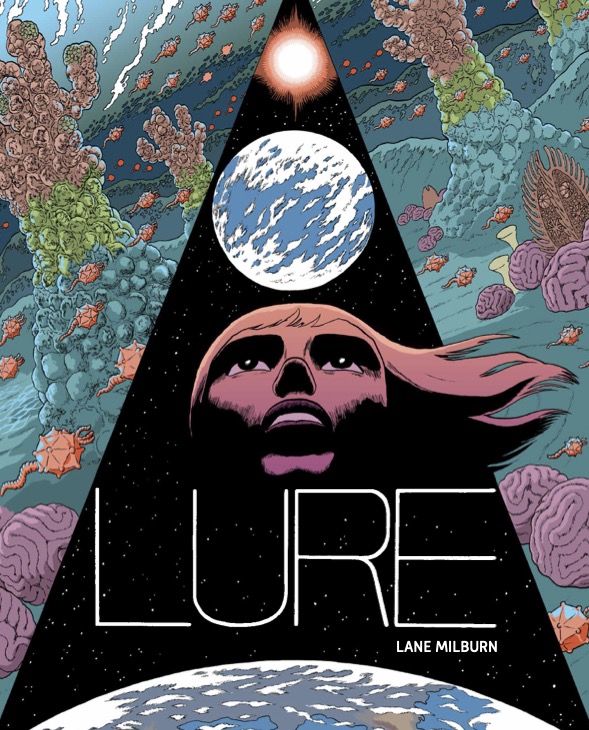Steeple: The Silvery Moon is funny. Whatever else this review might say, I think it’s important to explain this part in advance – this is a humor comic with good jokes in it. I laughed, I smiled, I chuckled sensibly. This is pretty important; for a form so associated with humor, the state of joke comics in recent decades had been pretty grim. Or maybe it’s just that I have become a grim, humorless individual, too tired and sad to understand the fast-paced, self-aware memeified gags of the new generation? Nope, it’s the children who are to blame.
The original Steeple miniseries (2019-20) showed Billie Baker, trainee priest for the Church of England, moving to the small-ish fictionalized town Tredregyn in Cornwall, England. She quickly discovers the community has some unique issues including (but not limited to): constant attacks by merfolk who terrorize the night; being a favorite yearly party destination for witches; and having a larger than expected population of Satan worshippers. This last bit becomes the focus of the plot as Billie, ever optimistic and pleasant, always looking for the best in everyone, strikes an unlikely friendship with Maggie Warren, who serves as a priestess in the Church of Satan. Why yes, it is another John Allison comic focusing on unlikely female friendship during times of growth and change.
If I sound cynical, I really shouldn’t. The fact is, Allison (Scary Go Round, Giant Days, Bad Machinery) has been playing this particular game for ages, having started in the early days of webcomics, and has gotten very good at it indeed. The characters are funny in their exaggerated personalities—Billie’s niceness, Maggie’s struggle with her constant impulses, Magus Tom’s commitment to petty evil—but never to degree by which they become flattened caricatures. The key feature of Allison’s style is that he never loses sight of the characters in search of the gag; he just sets these characters up and in a manner that allows the humor to occur 'naturally'. Allison would never do something as uncouth as allow someone to "break character" for a joke.

Volume 1 of Steeple ended with the two main protagonists exchanging places after a bit supernatural shenanigans (a fact that wasn’t all that clear in that ending, and is thankfully reinforced in the prologue for volume 2). All of which means this collections can also work as a decent standalone story about a woman who brings the chipper energy of a newly minted community organizer to an organization dedicated to sin and debauchery, while her opposite number tries very hard to fit into a new moral framework that she doesn’t quite understand.
Some of the gags in this collection are based on the expected meeting of the supernatural and the boring-normal; there are new age witches experimenting badly with removing curses, there’s a werewolf with a love for dad-television - giant sized monsters come to visit from another genre entirely. And these jokes are funny, because Allison knows how to keep balance of the story, without overwhelming the story. This is a story about people, and like a lot of latter Allison, it is wonderfully observed.

Check out this page from the first chapter. Not just the writing—though you get the texture of the relationship between Maggie and Billie just based on the sneaking of the forbidden biscuit in panel 2—but everything about the page that constantly explains what the characters are and reinforces their relationship to one another. You can erase every single word from this page (don’t do it, please, the dialogue is quite good) and you’d still get who these people are from expressions, from body language, from their choice of clothes. You believe these people can exist, you recognize their struggles for self-definition inside their little community. Even bit players, such as local drill rap group, are allowed to be more than just a cheap gag. You can imagine just about any character here spun off to their own successful strip (which is something Allison had done before).

Allison certainly has come a long way since his early days as a webcomics artist in that wild west period in which artistic standards were almost non-existent - of flat figures standing almost still and exchanging barbs. Not that his stuff is particularly flashy now—you won’t confuse his work to the wild cartoonish exuberance of regular collaborator Max Sarin—but it is pitched at the right level for the material. And he can swing for the fences when the time comes; a scene heralding the arrival of a giant monster has a real stylistic flair to it, sculpting the page in black to highlight a few hard blocks of color. I wouldn’t call it ‘Alex Toth-like’, but if I’d use it as a descriptor for the sort of visual effect it had on me, hopefully you wouldn’t toss me too hard through the nearest window (we are playacting a reality in which Alex Toth fans are not all frail individuals in their 50s).

Again, this is all about the observational stuff, grounding the characters in their world and letting both them and it radiate personality. Most of Allison’s work throughout the years takes place in the fictional city of Tackleford (some digital-only stories show that Steeple also takes place in the same fictional universe), and while it is a cliché to say ‘the city is a character’, well… fine, I wouldn’t say it. But it is a really well-developed setting, which probably means a lot more to regional fans. No doubt my crude, non-Yorkshire brain misses a lot of references.
Allison’s other recent print series, the 12-issue By Night with artist Christine Larsen and colorist Sarah Stern, played along similar lines. That series, however, took place the USA and was of a more dramatic bent. As a result, it didn’t work as well - a slow-burning tragedy about the death of small towns whose overarching themes clashed badly with the comedy supernatural stuff. By Night felt less about a place and more about a notion of place; an idea of an idea. Steeple, meanwhile, is back on solid ground. I have no doubt that there’s a lot of commentary that I’m missing, on the nature of small English towns or the slow decline of Anglican churches, but none of it interferes with my enjoyment of the story. Tredregyn is well-developed enough for me to accept as is, without referring to any particular architype it might be commenting upon (though I am certain the commentary is there).
Twenty odd years into his career, developing the same worlds, same characters and many of the same themes, John Allison could’ve easily gave in to the rut; become like one of those strip artists of old who carry on only out of sheer inertia. Instead, he has shown the ability to develop and refine his craft as a writer and an artist as he goes along. True believers (Bobbins-heads? Tackle-fans?) might argue over whether Steeple is better or worse than the recently completed Bad Machinery, but based on all of this I believe the best is yet to come.







